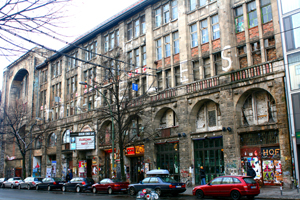
BERLIN (AFP) – German Bailiffs and police on Tuesday cleared a huge building in central Berlin that had been occupied by squatting artists since 1990 and became an iconic magnet for tourists.
The dilapidated five-storey Tacheles building was seized without violent resistance, according to an AFP reporter at the scene, after housing dozens of artists in different workshops for free since the fall of the Berlin Wall.
Nevertheless its closure sparked a protest, with two black-clad Tacheles artists playing a funeral march ahead of the police’s arrival at the site in the Mitte district, in former East Berlin.
“This is the theft of a work of art, supported by the police,” said Tacheles spokesman Martin Reiter, speaking to 100 or so supporters and journalists gathered outside the 1909 building.
“Berlin will soon stop being sexy,” read a banner, in reference to Berlin Mayor Klaus Wowereit’s famous description of his city as “poor but sexy.”
After the previous owner ran into financial difficulties, the building fell into the hands of HSH Nordbank, which decided to sell it, requiring its complete clearance.
The building stretches over 13,454 square feet and houses a cinema, restaurant and bar, in addition to the artists’ studios and galleries.
Young artists flocked to east Berlin after the fall of the Wall in 1989, drawn by the low cost of living, and squatted or moved their workshops into disused buildings.
“Attracted by low prices and the creative atmosphere which followed the collapse of the communist GDR (German Democratic Republic), many foreign artists moved to Berlin,” Harriet Haeussler, a professor at Berlin’s Free University, said.
But after the government moved from Bonn back to reunified Germany’s capital of Berlin in 1999, the city became home to a host of better-off residents, from politicians to lobbyists.
“The dilapidated apartment blocks were sold to investors who renovated them after having cleared the former occupants out. They rented them again for more,” Haeussler said.
ADDITIONAL IMAGE OF NOTE



